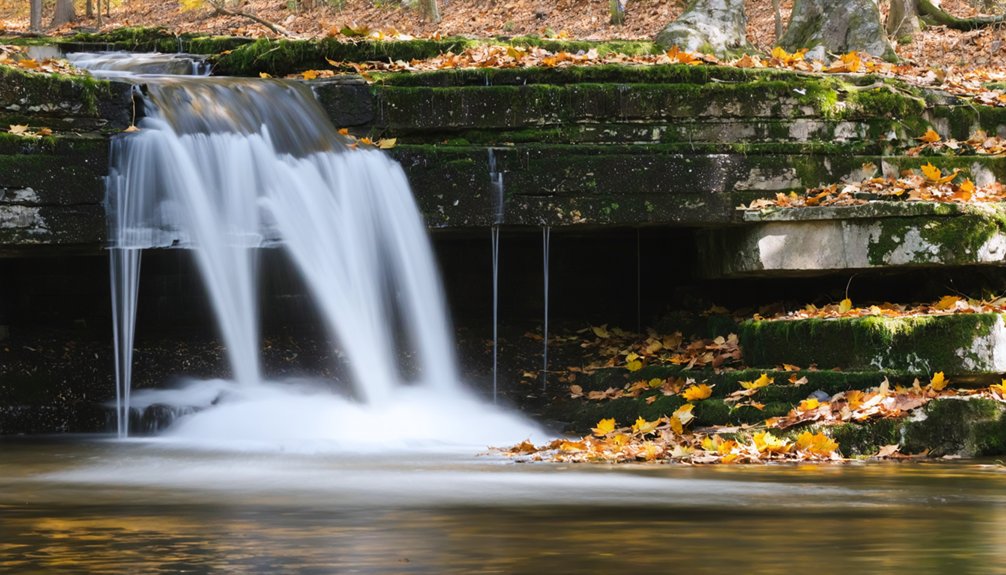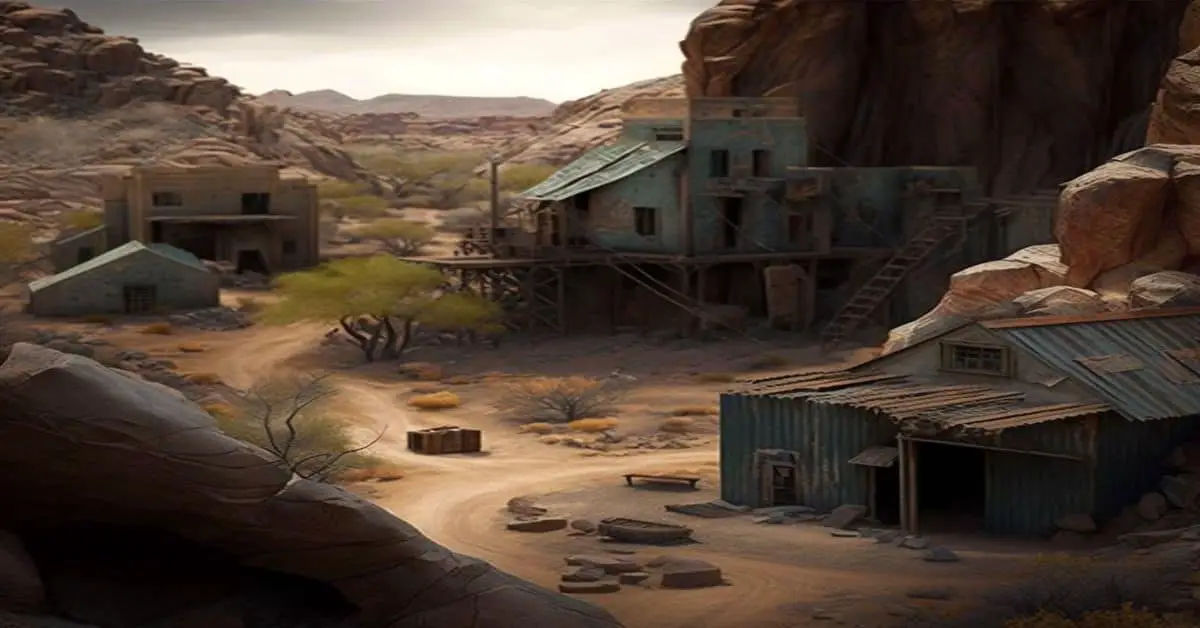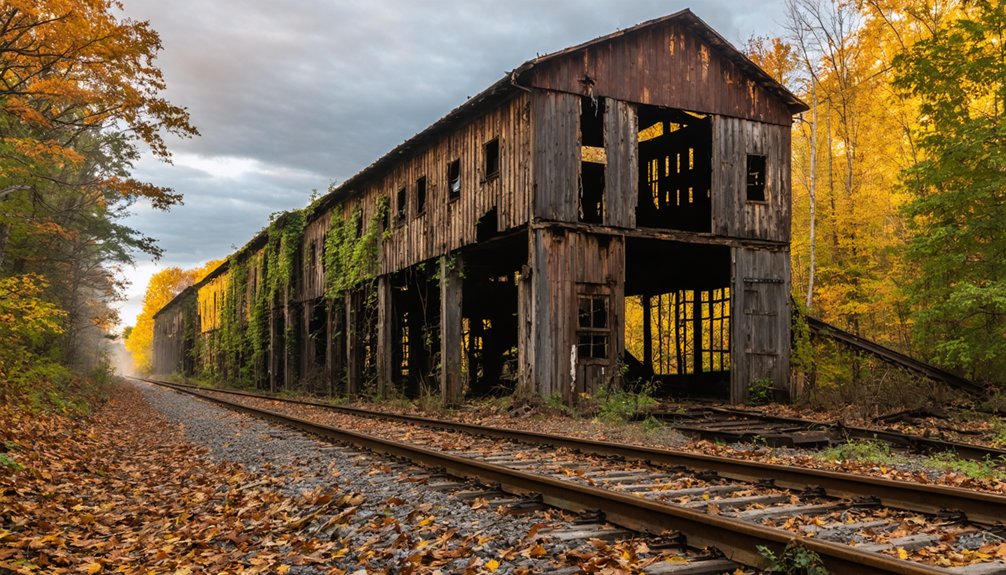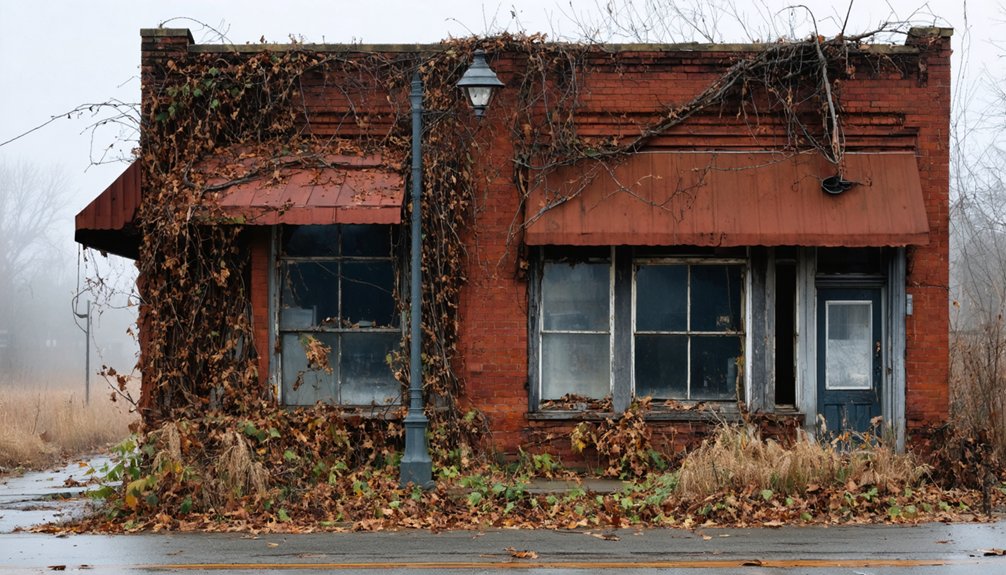You’ll find Hindostan Falls‘ haunting remains along Indiana’s East Fork of the White River, where Frederick Schultz founded a bustling frontier town in 1808. By 1820, this strategic settlement boasted 1,200 residents, mills, a hotel, and a button factory. A devastating cholera epidemic in the 1820s killed 138 people within three months, leading to the town’s abandonment. Today, a 1966 historical marker and local legends of buried treasure mark this once-prosperous settlement’s dramatic tale.
Key Takeaways
- Hindostan Falls was Indiana’s largest frontier town by 1820, with 1,200 residents, before becoming a ghost town following devastating epidemics.
- A cholera outbreak in the 1820s killed 138 residents within three months, causing mass evacuations and the town’s ultimate abandonment.
- The settlement featured two mills, a button factory, and a post office before disease and mass exodus led to its decline.
- Today, only natural remnants exist at the site along the White River, with a 1966 historical marker commemorating its significance.
- Local legends persist about buried treasure and ghostly spirits from residents who fled during the epidemic’s devastation.
The Rise of a Frontier Boomtown
When Frederick Schultz established Hindostan Falls in 1808, he recognized the strategic potential of the East Fork of the White River’s falls for both water power and transportation.
Despite frontier challenges, the settlement quickly grew into Indiana’s largest frontier town, reaching 1,200 residents by 1820. You’ll find that the community’s resilience showed in its rapid development of essential infrastructure, including two mills, a hotel, and a post office. The town also featured a button factory that provided local employment.
Named by British East India Company veteran Captain Caleb Fellows, the town flourished as an important stop on the stagecoach route between New Albany and Vincennes.
As Martin County’s seat, Hindostan Falls attracted settlers who built thriving industries, including whetstone and button factories. Many residents adapted to river life, choosing to live on houseboats along the White River, creating a unique frontier settlement pattern. A devastating cholera outbreak in the early 1820s decimated the population, with 138 deaths recorded within just three months.
Life Along the White River
As the White River carved its path through central Indiana over 20,000 years ago, it created a rich ecosystem that shaped the lives of countless generations along its banks.
You’ll find diverse river ecosystems throughout its reaches, from Meadow to Quarry to Protected, where tributaries like Stony Creek and Fall Creek join the main channel.
Before European settlement, the Miami people called this waterway Wapahani, meaning “white sands.” Their indigenous traditions centered on the river’s abundance, using it for fishing, transportation, and trade.
The fertile floodplains provided rich soil for agriculture, while the corridor teemed with wildlife that sustained communities. The Central Canal project attempted to enhance river connectivity but ultimately failed to achieve its transportation goals. Stretching for 362 miles through Indiana, the river remains a vital lifeline for communities along its course.
Today, you can still trace this heritage through Native place names and archaeological sites that remind us of the deep connection between the river and its earliest inhabitants.
Economic Glory Days and Innovation
The strategic location of Hindostan at the falls of the East Fork of the White River sparked its rapid transformation into a bustling economic powerhouse. By 1820, you’d find nearly 1,200 residents engaged in river commerce and industrial innovation, making it one of Indiana’s largest frontier settlements. Many residents conducted business from houseboats anchored along the bustling riverfront.
- Harnessing water power, the town’s gristmill and sawmill drove early industrialization, processing grain and lumber for distant markets.
- You could transport goods via river to New Orleans, connecting local merchants to profitable Mississippi River trade routes.
- The town’s position along major stagecoach routes attracted diverse merchants and craftsmen, creating a vibrant economic hub.
- Local natural resources, including timber and clay deposits, supported sustained industrial growth through pottery and lumber production.
Early entrepreneurs leveraged both river and land routes, establishing Hindostan as a critical regional center for manufacturing and trade. Under the leadership of Captain Caleb Fellows, the town established essential services that fueled its economic growth.
The Devastating Epidemic’s Toll
Disease struck Hindostan Falls with devastating force in the early 1820s, releasing a perfect storm of cholera, yellow fever, and other water-borne illnesses that would decimate the thriving frontier settlement.
The epidemic timeline unfolded rapidly – within three months, 138 residents perished, and the town’s population of 1,200 was cut in half by 1824.
Despite attempts at community resilience, you’d have witnessed desperate measures: mass graves holding up to 100 bodies, burning of homes where entire families died, and a mass exodus of survivors.
Faced with mounting deaths, townspeople resorted to mass burials and burning infected homes before fleeing their once-prosperous settlement.
The town’s strategic location along the White River, once a source of prosperity, became its downfall as river traffic and floodplains created ideal conditions for disease vectors. Many residents living in houseboats along riverbanks were particularly vulnerable to the spreading illness.
Hindostan Falls never recovered, losing its county seat status and fading into abandonment.
Modern Day Remnants and Local Legends
While natural forces have reclaimed most traces of the once-thriving settlement, modern-day Hindostan Falls exists primarily as a quiet natural area frequented by fishermen and history enthusiasts. The site rests along the historic stagecoach route that once connected Vincennes to New Albany. Caleb Fellowes’ wealth from his years of trading in India ultimately could not prevent the town’s abandonment.
Nature reclamation has left few visible remnants of the town’s bustling past, though you’ll find square cuts in the rock where mills once operated. A historical marker, erected in 1966, stands as the most prominent reminder of Hindostan’s significance to Indiana’s frontier history.
Local treasure legends continue to captivate visitors, with tales of:
- Buried gold awaiting discovery by fortune seekers
- Ghostly spirits haunting the former settlement
- The mysterious “Great Sickness” that decimated the population
- Hidden valuables left behind by fleeing residents
Today, you’ll find the site preserved more by natural forces than human intervention, creating an atmospheric backdrop for these enduring stories.
Frequently Asked Questions
Were Any Artifacts or Personal Belongings Ever Recovered From the Abandoned Town?
You’ll find mostly industrial artifact discoveries like mill-cut holes in rocks, but no significant personal belongings have been verified beyond folklore. Archaeological evidence remains limited to structural remnants.
What Was the Average Property Value in Hindostan Falls During Its Peak?
You won’t find exact property values from 1820s Hindostan Falls, as historical records don’t preserve these details. The strong property market and favorable economic conditions suggest values were competitive for that era.
Did Any Families Who Fled Successfully Resettle in Nearby Communities?
You’ll find that while resettlement patterns aren’t well documented, it’s believed several families successfully moved to Loogootee and other Martin County communities, though specific family legacies remain largely untraceable.
Were There Any Documented Native American Settlements Near Hindostan Falls?
Like scattered breadcrumbs in history, Native history near Hindostan Falls remains sparsely documented. You’ll find no confirmed tribal connections, though Miami and Shawnee peoples lived in the broader southern Indiana region.
How Did the Town’s Postal Service Operate During Its Brief Existence?
You’ll find that mail moved along postal routes via stagecoach between New Albany and Vincennes, with delivery challenges typical of frontier operations. The post office operated from a multi-purpose building until the town’s decline.
References
- https://www.discoversouthernindiana.com/blog/post/the-ghost-town-of-hindostan-falls-indianas-lost-jewel/
- http://exploresouthernindiana.blogspot.com/2011/10/haunting-of-hindostan-falls.html
- https://www.rgdodson.com/hindostan-indiana/
- https://www.in.gov/history/state-historical-markers/find-a-marker/site-of-hindostan-6-mile-south/
- https://go.gale.com/ps/i.do?id=GALE|A672359653&sid=googleScholar&v=2.1&it=r&linkaccess=abs&issn=1040788X&p=AONE&sw=w
- https://www.onlyinyourstate.com/experiences/indiana/vacant-ghost-town-rural-indiana
- https://www.folkstreams.net/contexts/pearl-fisher-hindostan-falls-and-india
- https://en.wikipedia.org/wiki/Hindostan_Falls
- https://www.discoversouthernindiana.com/listing/hindostan-falls/727/
- https://discoverwhiteriver.com/2021/11/03/white-river-history-general-history/



